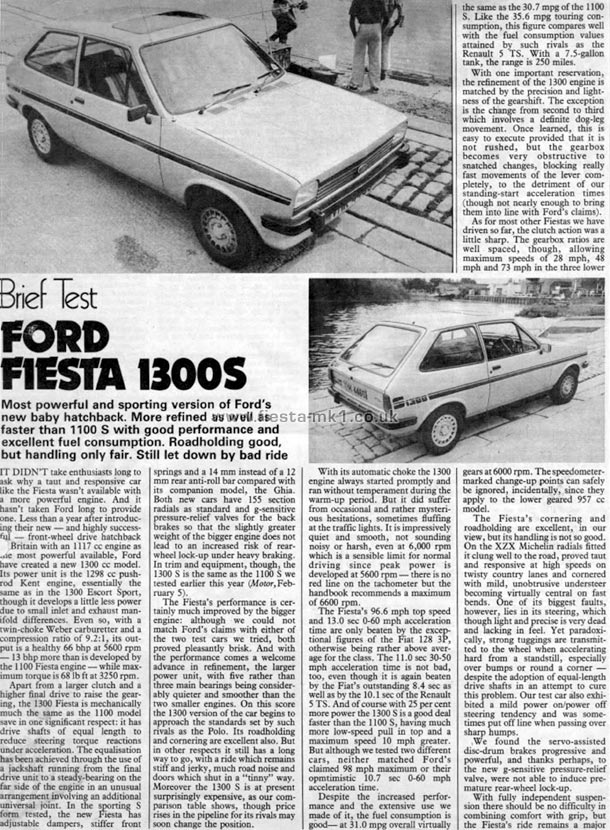Copy of Article Text Below
Brief Test - Ford Fiesta 1300S
Most powerful and sporting version of Ford's new baby hatchback. More refined as well as faster than 1100S with good performance and excellent fuel consumption. Roadholding good, but handling only fair. Still let down by bad ride.
IT DIDN'T take enthusiasts long to ask why a taut and responsive car like the Fiesta wasn't available with a more powerful engine. And it hasn't taken Ford long to provide one. Less than a year after introducing their new - and highly successful - front-wheel drive hatchback in Britain with an 1117 cc engine as the most powerful available, Ford have created a new 1300 cc model. Its power unit is the 1298 cc push-rod Kent engine, essentially the same as in the 1300 Escort Sport, though it develops a little less power due to small inlet and exhaust manifold differences. Even so, with a twin-choke Weber carburetter and a compression ratio of 9.2:1, its output is a healthy 66 bhp at 5600 rpm - 13 bhp more than is developed by the 1100 Fiesta engine - while maximum torque is 68 Ib ft at 3250 rpm.
Apart from a larger clutch and a higher final drive to raise the gearing, the 1300 Fiesta is mechanically much the same as the 1100 model save in one significant respect: it has drive shafts of equal length to reduce steering torque reactions under acceleration. The equalisation has been achieved through the use of a jackshaft running from the final drive unit to a steady-bearing on the far side of the engine in an unusual arrangement involving an additional universal joint. In the sporting S form tested, the new Fiesta has adjustable dampers, stiffer front springs and a 14 mm instead of a 12 mm rear anti-roll bar compared with its companion model, the Ghia. Both new cars have 155 section radials as standard and g-sensitive pressure-relief valves for the back brakes so that the slightly greater weight of the bigger engine does not lead to an increased risk of rear-wheel lock-up under heavy braking. In trim and equipment, though, the 1300S is the same as the 1100S we tested earlier this year (Motor, February 5).
The Fiesta's performance is certainly much improved by the bigger engine: although we could not match Ford's claims with either of the two test cars we tried, both proved pleasantly brisk. And with the performance comes a welcome advance in refinement, the larger power unit, with five rather than three main hearings being considerably quieter and smoother than the two smaller engines. On this score the 1300 version of the car begins to approach the standards set by such rivals as the Polo. Its roadholding and cornering are excellent also. But in other respects it still has a long way to go, with a ride which remains stiff and jerky, much road noise and doors which shut in a "tinny" way. Moreover the 1300S is at present surprisingly expensive, as our comparison table shows, though price rises in the pipeline for its rivals may soon change the position.
With its automatic choke the 1300 engine always started promptly and ran without temperament during the warm-up period. But it did suffer from occasional and rather mysterious hesitations, sometimes fluffing at the traffic lights. It is impressively quiet and smooth, not sounding noisy or harsh, even at 6,000 rpm which is a sensible limit for normal driving since peak power is developed at 5600 rpm - there is no red line on the tachometer but the handbook recommends a maximum of 6600 rpm.
The Fiesta's 96.6 mph top speed and 13.0 sec 0-60 mph acceleration time are only beaten by the exceptional figures of the Fiat 128 3P, otherwise being rather above average for the class. The 11.0 sec 30-50 mph acceleration time is not bad, too, even though it is again beaten by the Fiat's outstanding 8.4 sec as well as by the 10.1 sec of the Renault 5 TS. And of course with 25 per cent more power the 1300S is a good deal faster than the 1100S, having much more low-speed pull in top and a maximum speed 10 mph greater. But although we tested two different cars, neither matched Ford's claimed 98 mph maximum or their opmtimistic 10.7 sec 0-60 mph acceleration time.
Despite the increased performance and the extensive use we made of it, the fuel consumption is good- at 31.0 mpg overall virtually gears at 6000 rpm. The speedometer-marked change-up points can safely be ignored, incidentally, since they apply to the lower geared 957 cc model.
The Fiesta's cornering and roadholding are excellent, in our view, but its handling is not so good. On the XZX Michelin radials fitted it clung well to the road, proved taut and responsive at high speeds on twisty country lanes and cornered with mild, unobtrusive understeer becoming virtually central on fast bends. One of its biggest faults, however, lies in its steering, which though light and precise is very dead and lacking in feel. Yet paradoxically, strong tuggings are transmitted to the wheel when accelerating hard from a standstill, especially over bumps or round a corner - despite the adoption of equal-length drive shafts in an attempt to cure this problem. Our test car also exhibited a mild power on/power off steering tendency- and was sometimes put off line when passing over sharp humps.
We found the servo-assisted disc-drum brakes progressive and powerful, and thanks perhaps, to the new g-sensitive pressure-relief valve, were not able to induce premature rear-wheel lock-up.
With fully independent suspension there should be no difficulty in combining comfort with grip, but the Fiesta's ride remains a major.....
|


